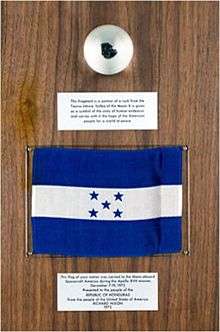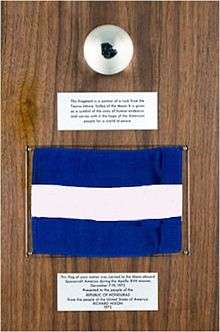Honduras lunar sample displays
The Honduras lunar sample displays are two commemorative plaques consisting of small fragments of Moon specimen brought back with the Apollo 11 and Apollo 17 lunar missions and given in the 1970s to the people of Honduras by United States President Richard Nixon as goodwill gifts.[1][2]
Description
Apollo 11
The Honduras Apollo 11 lunar sample display commemorative podium plaque consists of four "Moon rock" rice size particle specimens that were collected by Apollo 11 astronauts Neil Armstrong and Buzz Aldrin in 1969 and a small flag. The 4 "Moon rocks" weigh about 0.05 grams in total. They are encased in a clear plastic ball the size of a coin that is mounted to a wooden board approximately one foot square on a small podium pedestal display. The plaque display also has mounted on it a small Honduras flag that had been taken to the Moon and back on Apollo 11. The plaque display was given to the people of Honduras as a gift by President Richard Nixon. Similar lunar sample displays were also distributed to all the states of the United States and all the countries of the world.[1]
Apollo 17


The Honduras Apollo 17 lunar sample display commemorative plaque, measuring 10 by 14 inches, consists of one "Moon rock" particle specimen that was cut from lunar basalt 70017. This basalt was collected by Apollo 17 astronaut Harrison Schmitt on the Moon in 1972. Once lunar basalt 70017 was brought back to earth from the moon, the basalt Moon rock was cut up into small fragments of approximately 1 gram each. The specimen was encased in a plastic ball and mounted on the wooden plaque along with the Honduras flag which had been taken to the Moon and back by the crew of Apollo 17. The plaques were then distributed in 1973 by President Richard Nixon to all the countries of the world and the states of the United States as a goodwill gesture.[2]
History
The Honduras Apollo 17 "goodwill Moon rocks" plaque display, which was presented to the people of the Republic of Honduras in 1973 by President Nixon, came into the possession of retired colonel Roberto Agurcia Ugarte some time after 1993 and before 1995 in an illegal manner.[3] It is unclear how Ugarte obtained it.[4] Some speculate that he was inspired to steal the Honduras Apollo 17 "goodwill Moon rocks" plaque display with the 1 gram Moon rock because of the $442,500 selling price at a Sotheby's auction in December 1993 for a Russian sample of three tiny lunar pebbles weighing 0.2 grams that could only be seen under a microscope.[4] Ugarte put the plaque up for sale, covering the stars of the Honduras flag to give the impression that the NASA wooden plaque display could have come from one of several Central American countries (as many have the same colors on their flags). He eventually found a buyer for it, a fruit distributor named Alan Rosen.[4]
Rosen, a Floridian, was working in Honduras gathering fruit juice and selling it on his United States route. He heard "through the grapevine" that Ugarte wanted to sell the Honduras Apollo 17 "goodwill Moon rocks" plaque display. Rosen thought about the idea of purchasing it for a year, meanwhile verifying that NASA did not consider the gift to Honduras to be the property of the United States. Rosen checked with Harvard University that the Moon rock was real. He ultimately purchased the Honduras Apollo 17 "goodwill Moon rocks" plaque display from Ugate for what he claims was $50,000 in 1996.[5]
In 1998 NASA joined with the United States Postal Inspection Service to launch a sting operation called Operation Lunar Eclipse, which attempted to catch those trying to sell fake lunar rocks to unsuspecting buyers. An undercover agent placed ads in the USA Today newspaper under the banner "Moon Rocks Wanted". Rosen responded to one of these ads on September 29, 1998. NASA then enlisted United States Customs Service agents, who met with Rosen at a Miami restaurant. Rosen offered the Honduras Apollo 17 "goodwill Moon rocks" display to the undercover U.S. Customs agents for $5 million. The agents seized the Moon rock on the premise that it was a piece of property considered illegally imported into the United States. The proper Customs Service forms were not filled out as required by United States federal law. It was the first time an object from another celestial body brought back to earth by man had been recovered by a law enforcement agency.[4][6][7][8][9]
A lawsuit filed against Rosen in 2001, United States v. One Lucite Ball Containing Lunar Material (One Moon Rock) and One Ten Inch by Fourteen Inch Wooden Plaque,[10] went on trial and was settled in 2003. As a result of the trial, Rosen forfeited the Honduras Apollo 17 lunar sample plaque display, which was ultimately presented to Honduran President Ricardo Maduro on February 28, 2004.[4][6] The Honduras Apollo 17 goodwill Moon rock plaque, of as 2012, is on display in Tegucigalpa at Centro Interactivo Chiminike.[11]
According to Moon rocks researcher Robert Pearlman, the whereabouts of the Honduras Apollo 11 goodwill lunar display is unknown.[1]
References
- Pearlman, Robert (1999–2012). "Where today are the Apollo 11 goodwill lunar sample displays?". collectspace.com. Retrieved November 2, 2012.
- Pearlman, Robert (1999–2012). "Where today are the Apollo 17 goodwill moon rock displays?". collectspace.com. Retrieved November 2, 2012.
- UNITED STATES of America v. ONE LUCITE BALL CONTAINING LUNAR MATERIAL 252 F.Supp.2d 1367 (March 24, 2003). Text
- Reed, Christina (September 2002). "Geology and society: Moon rocks for sale!". GeoTimes. Archived from the original on 2003-05-18. Retrieved November 2, 2012.
- Pearlman, Robert (1999–2012). "Full coverage: Honduran moon rock on trial". collectspace.com. Retrieved November 2, 2012.
- Gutheinz, Joseph Richard (November 2004). "In Search of the Goodwill Moon Rocks: A Personal Account". GeoTimes. Retrieved November 2, 2012.
- Anzovin, p. 67 item #1808
- 19 U.S.C. 1595a(c)(1)(A)
- Earth magazine, March 2011, pp. 42-51
- Miami, Florida #01-0116-CIV-JORDAN
- Centro Interactivo de Enseñanza CHIMINIKE
Bibliographic information
- Anzovin, Steven (2000). Famous first facts, international edition: a record of first happenings, discoveries, and inventions in world history. New York: H.W. Wilson. ISBN 0824209583.
Further reading
- Kloc, Joe (February 19, 2012). The Case of the Missing Moon Rocks. The Atavist/Amazon Digital Services, Inc. p. 47. ASIN B007BGZNZ8.
External links
| Wikimedia Commons has media related to Honduras lunar sample displays. |
